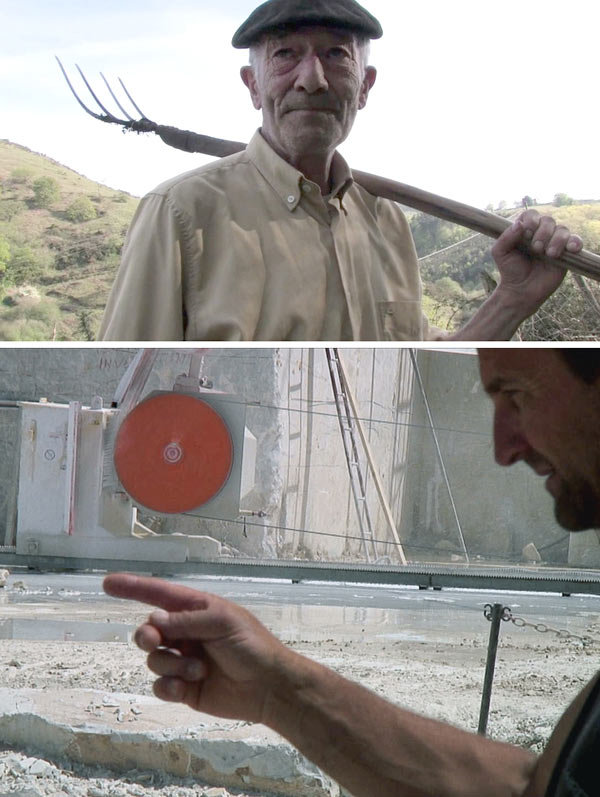Forged Power
dal 18/2/2010 al 28/5/2010
Segnalato da
18/2/2010
Forged Power
The ASU Art Museum, Tempe
Spanish artists Ferran Mendoza and Alvaro Sau traveled the Basque-French border region. The result of their journey is the video Outdoors, a work that delivers a composition of portraits. These portraits provide fleeting glimpses of individuals who take pride in their independence, work and know-how. In the historic quarries of Carrara, Italy, the stonecutters have worked for centuries excavating large slabs of white marble from the earth. Through a fellowship exchange, William Wylie was provided the opportunity to spend time observing the everyday operations and interactions of the men who work in these famous quarries.

Video art exhibition
Curated by John Spiak
Ferran Mendoza & Alvaro Sau, Outdoors, High Definition Video, 2009 William Wylie, Carrara series, Cavatori, The Block, Dust, Friction, Digital Video, 2006
In the digital age, the way we engage with physical work has drastically shifted. Such shifts are not new and have occurred over the course of human history - from the invention of simple tools to the industrial revolution, to our current digital society. But as technologies continue to advance, our control and power appear to diminish not only in our work, but also of our bodies. The body’s relationship to work continues to be less physical. We use mechanical arms to lift both heavy and light objects into place and vacuums now roam floors on their own. A document that once took the entire use of one’s arm to hand write can now be created with light touches of computer keys. With voice activation and eye-tracking technologies entering the mainstream consumer market, the hand may soon be removed altogether from the process of work.
Spanish artists Ferran Mendoza and Alvaro Sau traveled the Basque-French border region. The artists refer to it as “this kind of frontier land which we call the outdoors,” a territory of Europe where the “most archaic ways of living coexist with the omnipresent industrial world.” Using their cameras, Mendoza and Sau captured in high definition video the residents of this seemingly isolated region in their daily routines and surroundings. The result of their journey is the video Outdoors (2008), a 56-minute work that delivers a composition of portraits. These portraits provide fleeting glimpses of individuals who take pride in their independence, work and know-how. Their knowledge of their tools, their environment and how their bodies interact with each is clear and poetic; they perform their tasks as if every specific activity or action has been choreographed.
In the historic quarries of Carrara, Italy, the cavatori (stonecutters) have worked for centuries excavating large slabs of white marble from the earth. Through a fellowship exchange, artist William Wylie was provided the opportunity to spend time observing the everyday operations and interactions of the men who work in these famous quarries, the very quarries used by artists from Michelangelo to Louise Bourgeois. What at first appears to be a focus on machinery is soon realized to be a study of human activity and control. While trucks and machinery within these digital videos appear to struggle and battle to complete tasks, the cavatori work with their hands - making precision measurements and chiseling slight grooves. The artist captures in his Carrara series, Cavatori, The Block, Dust, and Friction (2006), the gestural engagements of the hand and body as the stonecutters work together, using signals and whistles, to coordinate their movements within the noise and chaos of the industrial site. Together these four videos demonstrate that the actions of work can be perceived as beautiful in and of themselves.
The individuals captured in these videos control their own actions by working with their hands and bodies. They do more than just push a button; they exert human energy and create an effect through the power of their own body. Retaining the capability of doing work or accomplishing tasks with the use of the physical body, their forged power is a reaffirmation of human capability.
The exhibition will feature five video works by the artists. William Wylie will be in attendance at ASU Art Museum to present a free lecture on a yet to be determined date. He will also meet with students and classes while in Tempe.
This exhibition and programs are generously supported by Helme Prinzen Endowment, ASU Art Museum Advisory Board, ASU School of Art and the Department of Photography, and Northlight Gallery at ASU.
Forged Power is an ASU Art Museum Moving Targets Initiative.
Image: video stills from Forged Power pieces; provided by artists
Feb. 19: Friday Conversations @11 with curator John Spiak, 11 a.m.
Opening Reception Feb. 19: Spring Season Reception, from 7-9pm. Free and open to the public.
ASU Art Museum
10th Street and Mill Avenue, Temple
Hours: Tuesday: During academic semesters 11 a.m. – 8 p.m.; Summer hours: 11 a.m. – 5 p.m.
Wednesday–Saturday: 11 a.m. – 5 p.m.
Additional educator hours by appointment: Mondays and before 11 a.m. Tuesday–Thursday
Closed: Sunday, Monday and holidays



